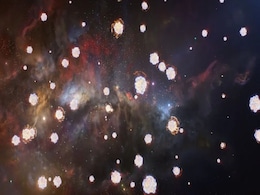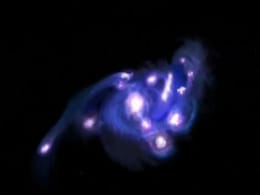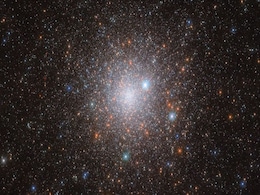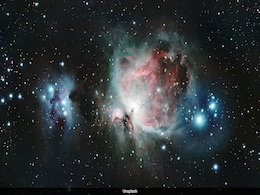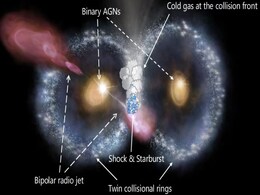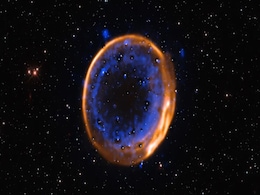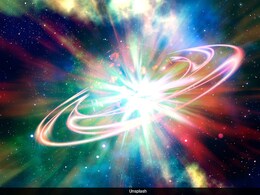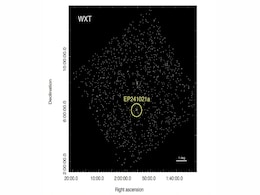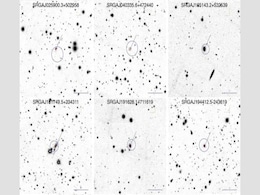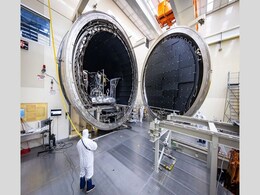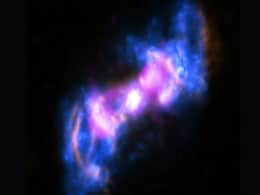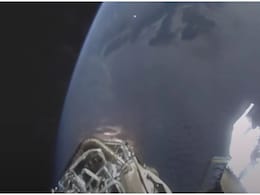Cosmic Understanding
- All
- News
-

Deep-Sea Beryllium-10 Hints at Supernova Debris Reaching Earth 10 Million Years Ago
- Tuesday September 30, 2025
- Written by Gadgets 360 Staff
A new study has uncovered deep-sea evidence suggesting Earth may have been struck by debris from a nearby exploding star 10 million years ago. Scientists found unusually high levels of Beryllium-10 in Pacific crusts, consistent with a supernova origin. The findings could transform understanding of cosmic influences on Earth’s history, though terr...
-
 www.gadgets360.com
www.gadgets360.com
-

Scientists Recreate Universe’s First Molecules, Challenging Early Star Formation Theories
- Tuesday August 19, 2025
- Written by Gadgets 360 Staff
Scientists have recreated helium hydride ions, the universe’s first molecules, under lab conditions. The study reveals these ions were far more effective in driving early star formation than older theories suggested. Published in Astronomy and Astrophysics, the research reshapes understanding of early cosmic chemistry and challenges assumptions a...
-
 www.gadgets360.com
www.gadgets360.com
-

Astronomers Discover "Cosmic Grapes" Galaxy Packed with Star-Forming Clumps in the Early Universe
- Friday August 15, 2025
- Written by Gadgets 360 Staff
The "Cosmic Grapes" galaxy discovery sheds new light on early galaxy formation, revealing unexpected dense, star-forming clumps just 930 million years post-Big Bang. Uncovered through JWST, ALMA, and gravitational lensing, this breakthrough opens new opportunities for understanding the early cosmos.
-
 www.gadgets360.com
www.gadgets360.com
-

Hubble Unveils Dark Matter Web in Stunning Abell 209 Galaxy Cluster Image
- Sunday July 20, 2025
- Written by Gadgets 360 Staff
NASA/ESA’s Hubble Space Telescope has released a stunning new image of Abell 209, a massive galaxy cluster 2.8 billion light-years away in Cetus. The golden cluster houses over 100 galaxies, but beneath them lies an invisible web of hot gas and dark matter. Using gravitational lensing, Hubble reveals curved arcs of light from background galaxies,...
-
 www.gadgets360.com
www.gadgets360.com
-

Crystalline Ice Discovered in Space: New Study Reveals Hidden Order in Cosmic Ice
- Tuesday July 15, 2025
- Written by Gadgets 360 Staff
A groundbreaking study from University College London and the University of Cambridge reveals that water ice in space, long believed to be completely amorphous due to extreme cold, may actually contain up to 25% crystalline structure. Simulations and X-ray diffraction experiments confirm the presence of nanocrystals in so-called low-density amorpho...
-
 www.gadgets360.com
www.gadgets360.com
-

Is Earth In A Giant Cosmic Void? Why New Research Could Change Everything
- Wednesday July 9, 2025
- Science | Edited by Nikhil Pandey
New research suggests Earth may lie inside a massive, billion-light-year-wide cosmic void, offering a possible solution to the Hubble Tension and changing our understanding of the universes expansion.
-
 www.ndtv.com
www.ndtv.com
-

James Webb Telescope Spots Rare ‘Cosmic Owl’ Formed by Colliding Galaxies
- Monday July 14, 2025
- Written by Gadgets 360 Staff
NASA’s James Webb Space Telescope has unveiled the “Cosmic Owl,” a jaw-dropping image of two colliding ring galaxies forming a structure that resembles an owl’s face. This double-ring formation is extraordinarily rare, and the event is shedding light on galaxy evolution, black hole dynamics, and rapid star formation. Led by Ph.D. student Mi...
-
 www.gadgets360.com
www.gadgets360.com
-

Astronomers Capture First-Ever Image of a Dead Star That Exploded Twice in Rare Supernova Event
- Saturday July 5, 2025
- Written by Gadgets 360 Staff
Astronomers have captured the first-ever image of a white dwarf star undergoing a rare double-detonation supernova. Using the Very Large Telescope, the team revealed that such explosions can occur without a star reaching the Chandrasekhar limit. The findings, published in Nature Astronomy, could reshape existing theories about stellar death and imp...
-
 www.gadgets360.com
www.gadgets360.com
-

Scientists Observe Light Of "Cosmic Dawn" With Telescope On Earth For The First Time Ever
- Thursday June 12, 2025
- Science | Edited by Srishti Singh Sisodia
Cosmic dawn insights shed light on the universe's early stages, providing an understanding of the universe's origins.
-
 www.ndtv.com
www.ndtv.com
-

Einstein Probe Detects Mysterious X-ray Flare with Record-Long Emission
- Tuesday May 27, 2025
- Written by Gadgets 360 Staff
An international team of astronomers has detected a peculiar fast-evolving X-ray transient, EP241021a, using China’s Einstein Probe. Unveiled in a May 12 arXiv paper, this transient stood out due to its long-lasting emissions lasting over 79 days—unprecedented among FEXTs. EP241021a also produced optical and radio emissions, suggesting a multi-...
-
 www.gadgets360.com
www.gadgets360.com
-

Russian Researchers Discover 11 New Active Galactic Nuclei In Spektr-RG X-ray Survey
- Saturday May 17, 2025
- Written by Gadgets 360 Staff
In a significant step for extragalactic astronomy, researchers from the Russian Academy of Sciences have identified 11 new active galactic nuclei (AGNs) through the ART-XC telescope aboard the Spektr-RG space observatory. These AGNs, classified as Seyfert galaxies, span redshifts from 0.028 to 0.258 and display X-ray luminosities typical for the pr...
-
 www.gadgets360.com
www.gadgets360.com
-

NASA’s IMAP Spacecraft Prepares to Map the Solar System’s Edge
- Thursday May 15, 2025
- Written by Gadgets 360 Staff
NASA’s Interstellar Mapping and Acceleration Probe (IMAP) has been delivered to the Astrotech facility near Kennedy Space Center for final preparations ahead of a tentatively planned launch in fall 2025. IMAP will map the heliosphere — the solar wind-driven bubble that shields our solar system from cosmic radiation. It is to orbit near Lagrange...
-
 www.gadgets360.com
www.gadgets360.com
-

The Universe’s Brightest Lights Have Surprisingly Dark and Mysterious Origins
- Saturday May 3, 2025
- Written by Gadgets 360 Staff
NASA’s Fermi Gamma-ray Space Telescope has revealed that some of the universe’s brightest light sources originate near supermassive black holes in galaxy centres. These active galactic nuclei emit intense radiation, including gamma rays and X-rays, despite black holes themselves being invisible. Their powerful jets and high-energy emissions cha...
-
 www.gadgets360.com
www.gadgets360.com
-

New Study Uncovers Shadowy Origins of Universe’s Most Luminous Phenomena
- Friday May 2, 2025
- Written by Gadgets 360 Staff
NASA’s Fermi Gamma-ray Space Telescope has revealed that some of the universe’s brightest light sources originate near supermassive black holes in galaxy centres. These active galactic nuclei emit intense radiation, including gamma rays and X-rays, despite black holes themselves being invisible. Their powerful jets and high-energy emissions cha...
-
 www.gadgets360.com
www.gadgets360.com
-

Deep-Sea Beryllium-10 Hints at Supernova Debris Reaching Earth 10 Million Years Ago
- Tuesday September 30, 2025
- Written by Gadgets 360 Staff
A new study has uncovered deep-sea evidence suggesting Earth may have been struck by debris from a nearby exploding star 10 million years ago. Scientists found unusually high levels of Beryllium-10 in Pacific crusts, consistent with a supernova origin. The findings could transform understanding of cosmic influences on Earth’s history, though terr...
-
 www.gadgets360.com
www.gadgets360.com
-

Scientists Recreate Universe’s First Molecules, Challenging Early Star Formation Theories
- Tuesday August 19, 2025
- Written by Gadgets 360 Staff
Scientists have recreated helium hydride ions, the universe’s first molecules, under lab conditions. The study reveals these ions were far more effective in driving early star formation than older theories suggested. Published in Astronomy and Astrophysics, the research reshapes understanding of early cosmic chemistry and challenges assumptions a...
-
 www.gadgets360.com
www.gadgets360.com
-

Astronomers Discover "Cosmic Grapes" Galaxy Packed with Star-Forming Clumps in the Early Universe
- Friday August 15, 2025
- Written by Gadgets 360 Staff
The "Cosmic Grapes" galaxy discovery sheds new light on early galaxy formation, revealing unexpected dense, star-forming clumps just 930 million years post-Big Bang. Uncovered through JWST, ALMA, and gravitational lensing, this breakthrough opens new opportunities for understanding the early cosmos.
-
 www.gadgets360.com
www.gadgets360.com
-

Hubble Unveils Dark Matter Web in Stunning Abell 209 Galaxy Cluster Image
- Sunday July 20, 2025
- Written by Gadgets 360 Staff
NASA/ESA’s Hubble Space Telescope has released a stunning new image of Abell 209, a massive galaxy cluster 2.8 billion light-years away in Cetus. The golden cluster houses over 100 galaxies, but beneath them lies an invisible web of hot gas and dark matter. Using gravitational lensing, Hubble reveals curved arcs of light from background galaxies,...
-
 www.gadgets360.com
www.gadgets360.com
-

Crystalline Ice Discovered in Space: New Study Reveals Hidden Order in Cosmic Ice
- Tuesday July 15, 2025
- Written by Gadgets 360 Staff
A groundbreaking study from University College London and the University of Cambridge reveals that water ice in space, long believed to be completely amorphous due to extreme cold, may actually contain up to 25% crystalline structure. Simulations and X-ray diffraction experiments confirm the presence of nanocrystals in so-called low-density amorpho...
-
 www.gadgets360.com
www.gadgets360.com
-

Is Earth In A Giant Cosmic Void? Why New Research Could Change Everything
- Wednesday July 9, 2025
- Science | Edited by Nikhil Pandey
New research suggests Earth may lie inside a massive, billion-light-year-wide cosmic void, offering a possible solution to the Hubble Tension and changing our understanding of the universes expansion.
-
 www.ndtv.com
www.ndtv.com
-

James Webb Telescope Spots Rare ‘Cosmic Owl’ Formed by Colliding Galaxies
- Monday July 14, 2025
- Written by Gadgets 360 Staff
NASA’s James Webb Space Telescope has unveiled the “Cosmic Owl,” a jaw-dropping image of two colliding ring galaxies forming a structure that resembles an owl’s face. This double-ring formation is extraordinarily rare, and the event is shedding light on galaxy evolution, black hole dynamics, and rapid star formation. Led by Ph.D. student Mi...
-
 www.gadgets360.com
www.gadgets360.com
-

Astronomers Capture First-Ever Image of a Dead Star That Exploded Twice in Rare Supernova Event
- Saturday July 5, 2025
- Written by Gadgets 360 Staff
Astronomers have captured the first-ever image of a white dwarf star undergoing a rare double-detonation supernova. Using the Very Large Telescope, the team revealed that such explosions can occur without a star reaching the Chandrasekhar limit. The findings, published in Nature Astronomy, could reshape existing theories about stellar death and imp...
-
 www.gadgets360.com
www.gadgets360.com
-

Scientists Observe Light Of "Cosmic Dawn" With Telescope On Earth For The First Time Ever
- Thursday June 12, 2025
- Science | Edited by Srishti Singh Sisodia
Cosmic dawn insights shed light on the universe's early stages, providing an understanding of the universe's origins.
-
 www.ndtv.com
www.ndtv.com
-

Einstein Probe Detects Mysterious X-ray Flare with Record-Long Emission
- Tuesday May 27, 2025
- Written by Gadgets 360 Staff
An international team of astronomers has detected a peculiar fast-evolving X-ray transient, EP241021a, using China’s Einstein Probe. Unveiled in a May 12 arXiv paper, this transient stood out due to its long-lasting emissions lasting over 79 days—unprecedented among FEXTs. EP241021a also produced optical and radio emissions, suggesting a multi-...
-
 www.gadgets360.com
www.gadgets360.com
-

Russian Researchers Discover 11 New Active Galactic Nuclei In Spektr-RG X-ray Survey
- Saturday May 17, 2025
- Written by Gadgets 360 Staff
In a significant step for extragalactic astronomy, researchers from the Russian Academy of Sciences have identified 11 new active galactic nuclei (AGNs) through the ART-XC telescope aboard the Spektr-RG space observatory. These AGNs, classified as Seyfert galaxies, span redshifts from 0.028 to 0.258 and display X-ray luminosities typical for the pr...
-
 www.gadgets360.com
www.gadgets360.com
-

NASA’s IMAP Spacecraft Prepares to Map the Solar System’s Edge
- Thursday May 15, 2025
- Written by Gadgets 360 Staff
NASA’s Interstellar Mapping and Acceleration Probe (IMAP) has been delivered to the Astrotech facility near Kennedy Space Center for final preparations ahead of a tentatively planned launch in fall 2025. IMAP will map the heliosphere — the solar wind-driven bubble that shields our solar system from cosmic radiation. It is to orbit near Lagrange...
-
 www.gadgets360.com
www.gadgets360.com
-

The Universe’s Brightest Lights Have Surprisingly Dark and Mysterious Origins
- Saturday May 3, 2025
- Written by Gadgets 360 Staff
NASA’s Fermi Gamma-ray Space Telescope has revealed that some of the universe’s brightest light sources originate near supermassive black holes in galaxy centres. These active galactic nuclei emit intense radiation, including gamma rays and X-rays, despite black holes themselves being invisible. Their powerful jets and high-energy emissions cha...
-
 www.gadgets360.com
www.gadgets360.com
-

New Study Uncovers Shadowy Origins of Universe’s Most Luminous Phenomena
- Friday May 2, 2025
- Written by Gadgets 360 Staff
NASA’s Fermi Gamma-ray Space Telescope has revealed that some of the universe’s brightest light sources originate near supermassive black holes in galaxy centres. These active galactic nuclei emit intense radiation, including gamma rays and X-rays, despite black holes themselves being invisible. Their powerful jets and high-energy emissions cha...
-
 www.gadgets360.com
www.gadgets360.com


